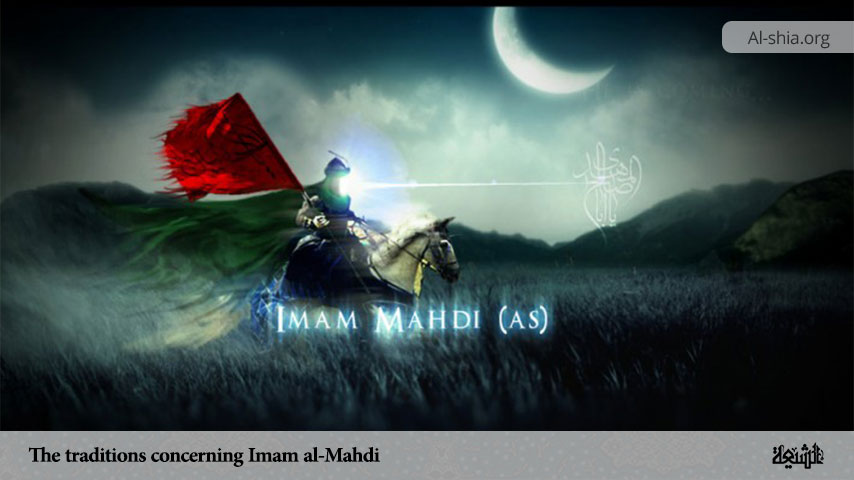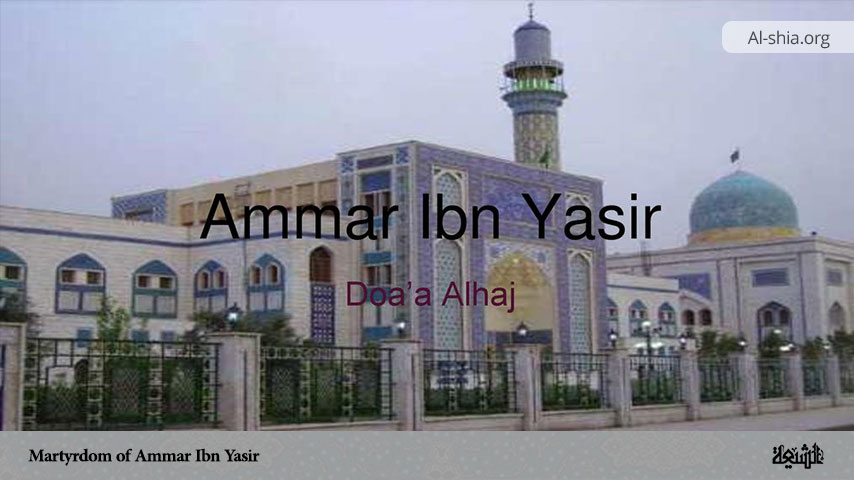There are many traditions attributed to the Prophet (PBUH&HP) in the books of tradition concerning the identity of Imam al-Mahdi, his family, his epithet (kunya) and his character. The conclusion of these numerous traditions is that al-Mahdi is a descendant of the sons of Holy Lady Fatima, (1) the daughter of the Prophet; and more particularly, that he is of the progeny of her son al-Husayn. His colour is similar to that of the Arab, his body is like the Israelite, and his name and kunya are similar to, the name and kunya of the Prophet (PBUH&HP). (2) Moreover some traditions claim that the Prophet said that al-Mahdi’s father’s name is like the name of the Prophet’s grandson, al-Hasan. Below are a number of these traditions:
1)We, the family of `Abd al-Muttalib, are the Masters of the inhabitants of Paradise: I, Hamza, Jafar, `Ali, al-Hasan, al-Husayn and al-Mahdi. (3)
2) Al-Mahdi is from my progeny. His name is similar to mine and his epithet is similar to mine. In his physique and character, he looks exactly like me. He will be in a state of occultation and there will be confusion (Hayra) in which people will wander about. Then he will come forth like a sharp, shooting star to fill the earth with justice and equity as it was filled before with injustice and inequity. (4)
3) Al-Mahdi is from my family (`itra) from the sons of Fatima. It is worth mentioning that this tradition was reported on the authority of Umm Salama by `Ali b. Nufayl, who died in 125/742. (5)
4) On the authority of Ibn ‘Abbas, the Prophet is reported to have said, “How shall Allah destroy a nation whose beginning is myself, whose end is Jesus and whose very centre is al-Mahdi, who will be from my family? (6)
5) The name of al-Mahdi’s father is similar to the name of my son al-Hasan. (7)
The conclusion of Osman concerning these traditions seems to be rather forced. “All these hadiths are weak and contradictory (mutadarib), therefore their attribution to the Prophet Muhammad is to be very much doubted. (8)
For the use of the epithet al-Mahdi by numerous Islamic groups, particularly the Zaydites, in their struggle for power during the Umayyad period shows that these traditions were well-known among the Muslims of that period. Moreover, many traditionists from different Islamic sects transmitted these traditions before the downfall of the Umayyad in 132/749, and later they were collected in the books of tradition (hadith).
The earliest of these books was Kitab Sulaym b. Qays, attributed to Sulaym b. Qays al-Hilali, who died between the years 80-90/699-708. He reports many Prophetic traditions concerning Imam al-Mahdi, his occultation and his reappearance. (9)
It appears from these two points that Osman’s judgement is somewhat hasty, particularly if one takes into account the fact that Prophetic traditions regarding Imam al-Mahdi were narrated by twenty-six companions of the Prophet. On their authority, thirty-eight traditionists recorded these traditions in their collections of hadith. (10) The evidence suggests that from the earliest times of Islam there was a belief that the Prophet had given his followers a promise about a man from the progeny of Imam al-Husayn, who would rise in arms in the future to purify Islam from innovation. But political rivalry amongst the Muslims encouraged some people to exploit this hope and to distort these Prophetic traditions in order to use them in their struggle for power. (11)
These traditions only mention that Imam al-Qaim al-Mahdi will be from the progeny of the Prophet. But there are also other traditions attributed to the Prophet which state that Imam al-Mahdi will, in fact, be the Twelfth Imam. It is true that Montgomery Watt objects that, Until al-`Askari died on 1st Jan. 874, there was nothing to make people expect that the number of the Imams would be limited to twelve or that the Twelfth would go into occultation. It follows the theory of the twelve Imams was worked out after 874. (12)
Nevertheless, there is ample proof that traditions claiming al-Qa’im would be the Twelfth descendant of the Prophet were in circulation before 874. It is thus necessary to throw light upon these traditions, which were, transmitted by Sunnites and Zaydites as well as Imamites so that one can see to what extent these traditions were used by the Imamite scholars to support the belief that the Twelfth Imam had not died but was in a state of occultation.
The Traditions of the Sunnites (Ahl al-Hadith)
The Sunnite books of tradition report three Prophetic traditions pertaining to the twelve Imams who would be the successors of the Prophet. These were narrated on the authority of seven companions of the Prophet, namely Jabir b. Samura, `Abd Allah b. Mas`ud, Anas b. Malik, `Umar b. al-Khattab, Wa’ila b. Asqa’, `Abd Allah b. `Umar and Abu Hurayra.
1)Jabir b. Samura narrates that he heard the Prophet say, “There will be after me twelve Amirs. “Then he mentioned something which I did not hear, so I asked my father, who was sitting beside me, who said, “All of whom will be from Quraysh. (13)
2)`Umar b. al-Khattab reports that he heard the Prophet say, “The Imams (al-A’imma) after me will be twelve, all of whom will be from Quraysh.(14)”
3)`Abd Allah b. Mas’ud was once reciting the Qur’an in a mosque in Iraq when a young man came and asked him if the Prophet had informed them about the number of his successors. Ibn Mas`ud replied, “The Prophet informed us that his successors will be twelve caliphs, whose number is similar to the number of the leaders (al-nuqaba) of Banu Isra’il. (15)
These traditions have been related by the traditionists and are considered authentic. Ibn Hanbal narrates the first with thirty-four chains of transmitters (sanad), all of which are on the authority of Jabir b. Samura,(16) although there are slight differences in the versions. Some of the narrators used the words Ami’r and Khalifa instead of Imam. But these traditions, as reported by the Sunnites, indicate only that the Prophet would be succeeded by twelve successors; none reveals that the Twelfth would go into occultation, nor that he would be al-Qaim al-Mahdi. But the Zaydite and the Imamite narrators relate the same traditions with phrases which indicate that the Twelfth Imam would be al-Qaim al-Mahdi. (17)
NOTES:
_________________________________________________
1. Ibn Maja, Sunan, vol. 2, 519; Abu Dawud, al-Sunan, vol. 2, 208.
2. al-Tirmidhi, vol. 9, 74, 75; and the Cairo edition, vol. 4, 505-6
3. Ibn Maja, Sunan, vol. 2, 1368.
4. Ibn Maja, Sunan, vol. 2, 1368. And: Kamal, 286-7. Al-Tirmidhi mentioned the same tradition on the authority of Ibn Mas`ud without any details concerning the occultation of the Mahdi. Al Tirmidhi, vol. 4, 505-6; al-Darimi, Sunan, vol. 4, 151.
5. Mizan,vol. 3, 160; Ibn Maja, Sunan, vol. 2, 1368; al-Musannaf, vol. 11, 372.
6. al-Thalabi, `Ara’is al-Majalis, 363; al-Kanji, op.cit., 327.
7. al-Haythami, al-Sawa`iq al-Muhriqa, 100.
8. Osman, Mahdism in Islam, Ph.D. Thesis (Edinburgh, 1976), 204.
9. Sulaym b. Qays al-Hilali, Kitab Sulaym b. Qays (Najaf, n.d.), 56, 159-62. Although this book has received some criticism with regard to its authenticity, a careful examination of its contents which show that it was regarded as a source by such writers as al-Kulayni in al-Kafi, al-Mas`udi in al-Tanbih wa-l-Ashraf and al-Nu’mani in Kitab al-Ghayba.
10. Abd al-Muhsin al-`Abbad, `Aqidat Ahl al-Sunna wa-l-Athar fi al-Mahdi al Muntazar, al-Hadi (Qumm, 1971) vol. 1, part 1, 33-5; al-Tabsi, al-Shi`a wa-l-Raja(Najaf, 1966), 36-54.
11. For the Umayyad and the `Abbasid use of the epithet al-Mahdi so as to gain political success, see al-Ishfahani, al-Aghani, vol. 16, 88; al-Darimi, Sunan, vol. 4, 152.
12. Watt, The Majesty that is Islam, 169-170.
13. al-Bukhari, al-Sahih (Cairo, 1355), vol. 4, 175; M. Sahih, vol. 3, 190-3; al-Tirmidhi, vol. 4, 501; Ibn Hanbal, al-Musnad (Cairo, 1313), vol. 5, 294.
14. al-Kharraz, Kifayat al-Athar, quoted by al-Galbaygani, Muntakhab al-Athar, 28.
15. Ibn Hanbal, al-Musnad, vol. 1, 398; al-Karajuki, al-Istibsar, 12.
16. Ibn Hanbal, al-Musnad, vol. 5, 86-90, 92-101, 106-8.
17. N.al-Ghayba, 48-9; Kamal, 270-3.


















